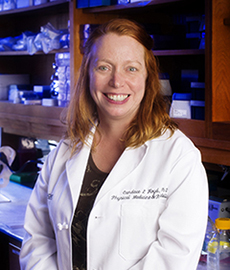Unique Team Inspires Spinal Cord Studies
By Jeff Hansen
 Candace Floyd aims to accelerate breakthrough studies in spinal cord injuries at UAB with the T.J. Atchison Spinal Cord Injury Research Program.At age 17, Candace Floyd, Ph.D., worked as an emergency medical technician and a hospital volunteer. She saw wreck victims and shaken babies who had suffered central nervous system trauma, and she resolved to help them.
Candace Floyd aims to accelerate breakthrough studies in spinal cord injuries at UAB with the T.J. Atchison Spinal Cord Injury Research Program.At age 17, Candace Floyd, Ph.D., worked as an emergency medical technician and a hospital volunteer. She saw wreck victims and shaken babies who had suffered central nervous system trauma, and she resolved to help them.
Roman Reed of California was paralyzed when a tackler crushed his vertebrae in a 1994 college football game. After his injury, Roman and others convinced the California legislature to pass "Roman's Law," an added fine on traffic tickets that would fund spinal cord injury research. In 11 years, the Roman Reed Foundation has awarded $12.5 million to researchers in spinal cord injury and regenerative medicine.
In Alabama, Chatom native and nursing student T.J. Atchison was determined to bolster spinal cord injury research after becoming paralyzed in a 2010 car wreck.
These three young people, from different parts of the country, are now helping to push the boundaries of the field and set the stage for potential new treatments at UAB.
"There is nothing we can do to repair the damaged tissue, or regenerate it," says Floyd, now a UAB associate professor who studies both brain and spinal cord injuries. "It's a travesty. I vowed that I was going to fix that."
Investments with Impact
A decade ago, Floyd was a postdoctoral fellow at the University of California Davis when she first heard of the newly formed Roman Reed Foundation. Though she studied brain trauma, she applied for and won one of the foundation's first pilot grants, meant to lure young investigators into spinal cord research.
That initial experimental idea fizzled, but her second—using estrogen therapy in spinal cord injury—launched a highly successful research program. By 2006, UAB and two other universities competed to recruit her to their faculties.
Floyd, impressed by research that complemented her work and a collaborative environment, chose UAB. But Reed remembered her five years later, when Atchison and family friend Tory Minus sought his help to pass "T.J.'s Law" for spinal cord injury research in Alabama. Floyd "was one of our stars," Reed said.
Atchison and Minus asked Floyd to lead a possible UAB research program modeled after Reed's. Floyd told them she had a million ideas on how to make such a program unique and successful if they got the funding.
Spinal StudiesSome research projects ongoing in the T.J. Atchison Spinal Cord Injury Program:• Evaluation of neuropathic pain after spinal cord injury with Michelle Olsen, Ph.D. • Evaluation of depression and antidepressant medications on rehabilitation and recovery with Sarah Clinton, Ph.D. • Examination of the effects of chronic stress on recovery after spinal cord injury with Meredith Robbins, Ph.D. • Evaluation of a novel therapeutic target, HuR, in spinal cord injury with Peter King, M.D. • Development of a novel nanomaterial matrix for regeneration and repair after spinal cord injury with Yogesh Vohra, Ph.D., and Vinoy Thomas, Ph.D. |
Alabama Senator Marc Keahey of Grove Hill headed that effort. During the 2012 legislative session, he persuaded lawmakers to add a $400,000 line item to the education budget for spinal cord research. The result is the T.J. Atchison Spinal Cord Injury Research Program led by Floyd in the UAB Department of Physical Medicine and Rehabilitation, as well as the T.J. Atchison Foundation, with Atchison as chair and Reed as a board member.
Special funding for spinal cord injury research is vital, Floyd explains. Drug companies don't invest a lot, because the patient population—and hence the drug market—is small. About 12,000 new spinal cord injury cases appear each year in the United States.
Yet Alabama is motivated to help find a cure. Care for spinal cord injuries in Alabama costs $515 million a year, Keahey has said, and the state pays $143 million for Medicaid and indigent care costs.
Goals for Discovery
Floyd says her research focuses on acute injury first—how to protect against the reactive damage that accompanies a spinal cord injury. Chronic injury research will follow, with the goal of regenerating nerve tissue after a gap has formed in the spinal cord.
"We will have an international competition each year," Floyd says. "Everybody will submit ideas, and we'll test the one that has the best and strongest evidence. The effect on research acceleration will be great."
Pilot programs are another part of the T.J. Atchison program. Researchers in a variety of medical fields can share and test their ideas about spinal cord injuries in Floyd's lab. One partnership has paired Floyd with UAB diabetes researcher Hubert Tse, Ph.D., who has investigated a catalytic oxidoreductant compound to effectively dissipate free radicals and inflammatory-mediated effects on pancreatic beta-cell destruction in Type 1 diabetes.
Together, they have applied the compound to acute spinal cord injuries, with "very impressive" results, Floyd says. Tse and Floyd now have a grant from the National Football League to also test the compound as a potential treatment for concussion.
A Future of Breakthroughs
Floyd and her colleagues, along with Atchison and Reed, are excited about the future of the field. They note that the T.J. Atchison Spinal Cord Injury Program also will fund research by medical students, residents, and biomedical engineering students, among others, and it will teach the value of research at Alabama elementary and secondary schools.
Each new study—and each new scientist—will bring UAB closer to the treatments that could change the lives of patients with spinal cord injuries.